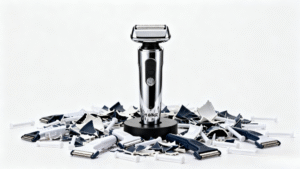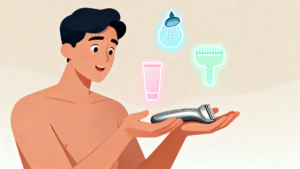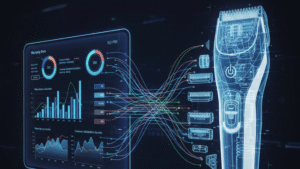The line between the bathroom cabinet and the medical clinic is blurring. Your smartwatch tracks your heart rate, your ring monitors your sleep, and your scale analyzes your body composition. We live in an era of data-driven wellness. So why is your grooming routine still operating on guesswork?
For decades, innovation in body trimmers meant a sharper blade or a longer-lasting battery. But the next frontier of innovation is far more ambitious. It’s the integration of Health Tech In Personal Care: the idea that our daily tools should not only perform a task but also provide intelligent feedback about our bodies. This has led to the most important question for every brand’s 2026 Product Roadmap Planning: Are embedded skin health sensors and other biometric technologies a passing gimmick, or will they become the next “must-have” feature that consumers demand?
What Does a “Clinical Groomer” Actually Look Like?
Before analyzing its viability, we must first imagine this new category of smart grooming devices. A “Clinical Groomer” is not just a trimmer; it’s a diagnostic tool that provides real-time, personalized feedback. This is made possible by integrating sophisticated Biometric Sensors that are commonplace in the medical device industry.
- The Technology:
- Hydration Sensors: A tiny sensor could measure your skin’s moisture levels before you shave, providing an objective measure of dryness or oiliness.
- Optical/Redness Sensors: Using LED light and a sensor, the device could detect early signs of inflammation or redness, warning you that an area is too sensitive to shave closely.
- Pressure Sensors: The groomer could provide haptic feedback (a gentle vibration) if you are pressing too hard, a primary cause of nicks and irritation.
- The User Experience: This data is then translated into actionable advice via a connected app, creating a truly personalized grooming routine. Imagine your app giving you these recommendations:
- “Your skin hydration is low today. We recommend using a pre-shave oil and switching to the ‘Sensitive Glide’ setting.”
- “Warning: Inflammation detected on your lower neck. Use the 3mm guard in this area to avoid irritation.”
This transforms the product from a simple tool into a personal grooming coach, a core tenet of the IoT (Internet of Things) ecosystem.

The “Why”: The Case for Health Tech Becoming a Must-Have – health tech in personal care
Three powerful forces are converging to make this futuristic concept an inevitable reality.
- The Rise of the “Quantified Self”: Consumers are now deeply accustomed to tracking their health data. We track steps, sleep cycles, heart rate variability, and more. Extending this tracking to skin health—the body’s largest organ—is a natural and logical next step.
- The Demand for Hyper-Personalization: Generic, one-size-fits-all advice is no longer sufficient. Data-driven, personalized recommendations are the future of all premium consumer products. A device that can offer advice tailored to your skin on this specific day offers an unparalleled Value Proposition.
- A Path Away from Commoditization: For brands, this is a powerful strategic move. A groomer that actively helps you preventing skin irritation has a much stronger and more defensible selling point than one that is simply “5% faster.” It allows brands to compete on innovation and wellness, escaping the price wars of the crowded standard electronics market.

The Reality Check: Hurdles and Challenges to Mainstream Adoption
While the vision is compelling, the path to making Health Tech In Personal Care a standard feature is filled with significant engineering and business challenges.
| Challenge | Description | B2B Implication for Brands & Manufacturers |
| Cost & Miniaturization | Adding medical-grade sensors significantly increases the Bill of Materials (BOM) cost and complexity. | Requires breakthroughs in sensor cost-reduction and collaboration with specialized MedTech suppliers (a key strength in places like Taiwan). |
| Accuracy & Reliability | Consumer-grade sensors must be accurate enough to be genuinely useful, not just a gimmick. | Demands extensive validation and Durability Testing, a process familiar to the R&D in Medical Devices industry. |
| Data Privacy & Security | Who owns the user’s sensitive skin data? How is it protected? | Brands must invest heavily in secure cloud infrastructure and transparent data privacy policies to build user trust. |
| User Interface (UI/UX) | The data must be presented to the user in a simple, actionable way through an app. A complex app will be ignored. | Requires a significant investment in software development and UX design, moving beyond traditional hardware engineering. |

The Verdict for 2026 and Beyond – health tech in personal care
So, will skin health sensors be a “must-have” feature in 2026?
The Short-Term (2026-2027): No. It will likely not be a mainstream, mass-market feature. Instead, it will be the key differentiator for high-end, premium “halo” products from the most innovative brands. It will be a powerful marketing story and a signal of a brand’s technological leadership, much like the first smartwatches were.
The Long-Term (2028+): Yes. As sensor costs inevitably decrease and consumer appetite for personalized health data continues to grow, these features will trickle down. We expect them to become a standard, expected feature in mid-to-high-range devices, much like waterproofing evolved from a niche feature to an industry standard over the past decade.
The Final B2B Takeaway: For brands and manufacturers, the question isn’t if they should explore Health Tech In Personal Care, but when and how. The companies that begin their R&D and forge partnerships with MedTech suppliers now—especially those located in manufacturing hubs like Taiwan that excel in both electronics and medical devices—will be the ones who define and lead this transformative trend.






